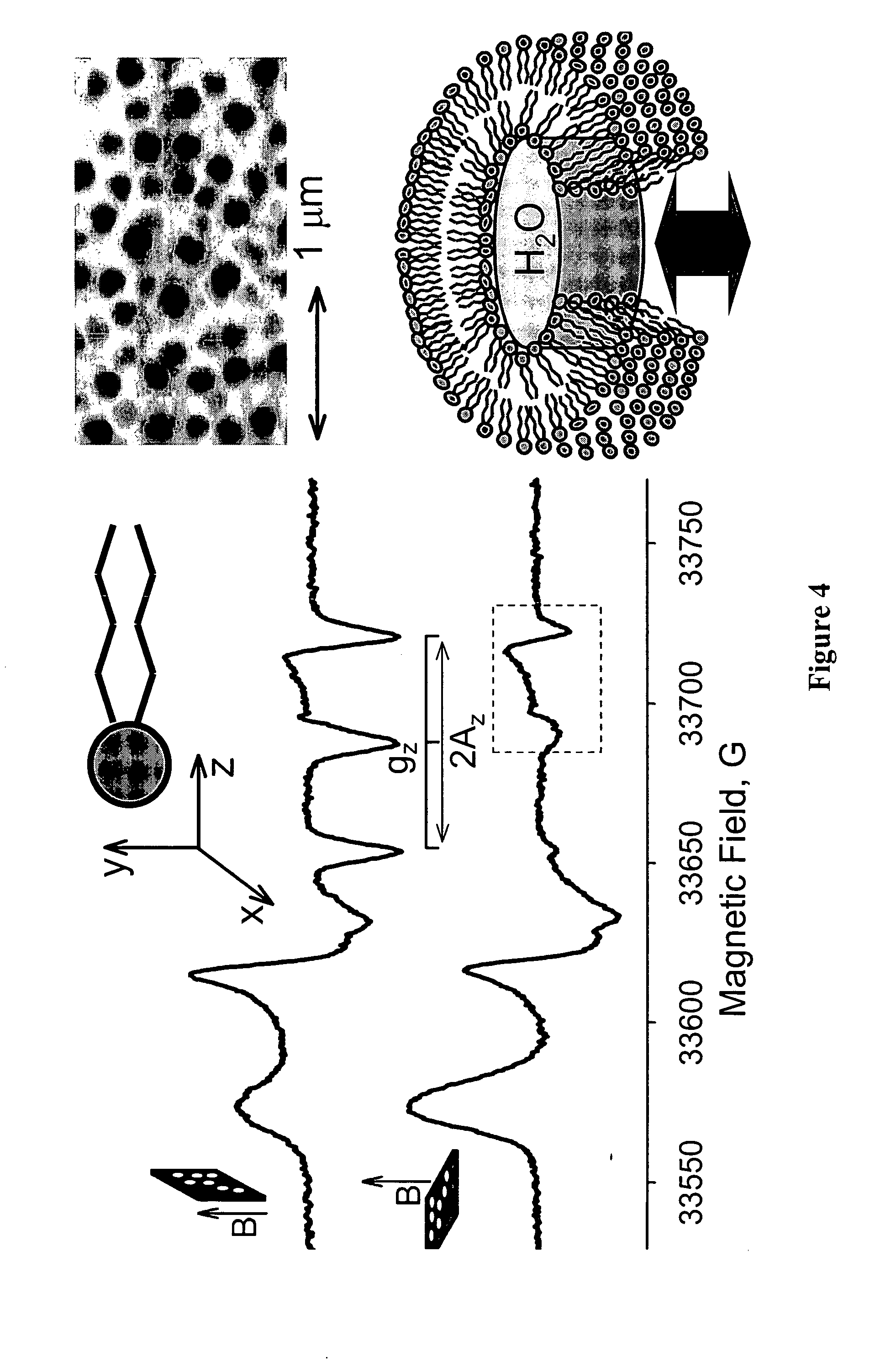Nanotube structures having a surfactant bilayer inner wall coating
a nanotube and inner wall coating technology, applied in the field of nanotube arrays and nanotube arrays, membrane biochips, can solve the problems of small mechanical perturbation or contamination of the surface, the planar lipid assembly and the protein-on-a-chip device is very fragile, and the technology is not suitable for robust arrays of biosensors
- Summary
- Abstract
- Description
- Claims
- Application Information
AI Technical Summary
Benefits of technology
Problems solved by technology
Method used
Image
Examples
example 1
[0052]Sample preparation. DMPC (1,2-dimyristoyl-sn-glycero-3-phosphocholine), 5PC (1-palmitoyl-2-Stearoyl-(5-doxyl)-sn-glycero-3-phosphocholine), and 16-PC (1-palmitoyl-2-Stearoyl-(16-doxyl)-sn-glycero-3-phospho-choline) were purchased from Avanti Polar Lipids (Alabaster, Ala.) in form of chloroform solutions and were stored at 223 K in a freezer prior to use. Spin-labeled multilamellar liposomes were prepared by mixing chloroform solutions of DMPC and 5PC or 16PC (all at concentration of 10-20 mg lipid / ml) in 100:1 molar ratio. After the mixing choloform was removed by a rotary evaporator yielding a thin lipid film on the sides of a round bottom flask. Residual chloroform was removed by keeping the vial on a vacuum pump with a nitrogen trap overnight. Multilamellar liposomes were formed by adding 50 mM TRIS pH=7.0 buffer and cycling the flask for at least five times between a container with liquid nitrogen and a water bath at 305 K. The final concentration of DPPC in aqueous media ...
example 2
Fast and Efficient Buffer Exchange with Nanopore-Supported Phospholipid Bilayers
[0060]Because the nanoporous channels remain accessible to water-soluble molecules after the lipid bilayers are deposited, buffer and salt concentration can be easily adjusted in a very short time. Preliminary EPR and FRAP (Fluorescence Recovery After Photobleaching—not shown) experiments show that small solute molecules diffuse through nanoporous channels freely with characteristic times of a few seconds over the entire length of ca. 60 μm channels.
[0061]FIGS. 6-8 illustrates the use of nanopore-supported bilayers for adjusting pH. In this experiment local pH was monitored using a characteristic splitting of EPR spectra—parameter Amax—of 5-doxyl stearic acid (structure is shown in the FIG. 6—top), which was used to label phospholipid bilayer composed of DMPC (1,2-dimyristoyl-sn-glycero-3-phosphocholine) in 1:100 molar ratio. This method has been initially described by Marsch and coworkers in application...
example 3
Writing on Nanotube Arrays
[0065]Phospholipid bilayers can be deposited onto nanoporous substrates using different techniques. FIGS. 9-10 demonstrate one such methods of depositing selectively labeled lipids (in this case—Phodamine-PE, 1,2-Dipalmitoyl-sn-Glycero-3-Phosphoethanolamine-N-(Lissamine Rhodamine B Sulfonyl); Ammonium Salt, purchased from Avanti Polar Lipids, Alabaster, Ala.) using a microcapillary tip that is controlled by a solenoid valve. In this example pattering was accomplished by transferring rhodamine-labeled bilayer dispersions from a fine tip and moving that tip over the AAO surface. Excess of phospholipids from the surface was removed by a 5 min low power sonication of the AAO chip bathed in an excess of buffer at 30° C. After that, the sample was kept in a buffer for 3 days at 4° C. and then fluorescence images were taken with a two-photon microscope. A sample image from such an experiment (FIG. 10) shows a clear pattern of perpendicular lines.
[0066]Another poss...
PUM
| Property | Measurement | Unit |
|---|---|---|
| length | aaaaa | aaaaa |
| length | aaaaa | aaaaa |
| diameter | aaaaa | aaaaa |
Abstract
Description
Claims
Application Information
 Login to View More
Login to View More - R&D
- Intellectual Property
- Life Sciences
- Materials
- Tech Scout
- Unparalleled Data Quality
- Higher Quality Content
- 60% Fewer Hallucinations
Browse by: Latest US Patents, China's latest patents, Technical Efficacy Thesaurus, Application Domain, Technology Topic, Popular Technical Reports.
© 2025 PatSnap. All rights reserved.Legal|Privacy policy|Modern Slavery Act Transparency Statement|Sitemap|About US| Contact US: help@patsnap.com



